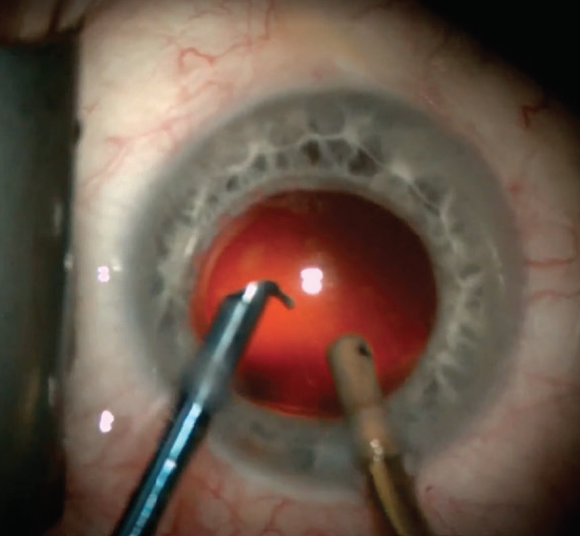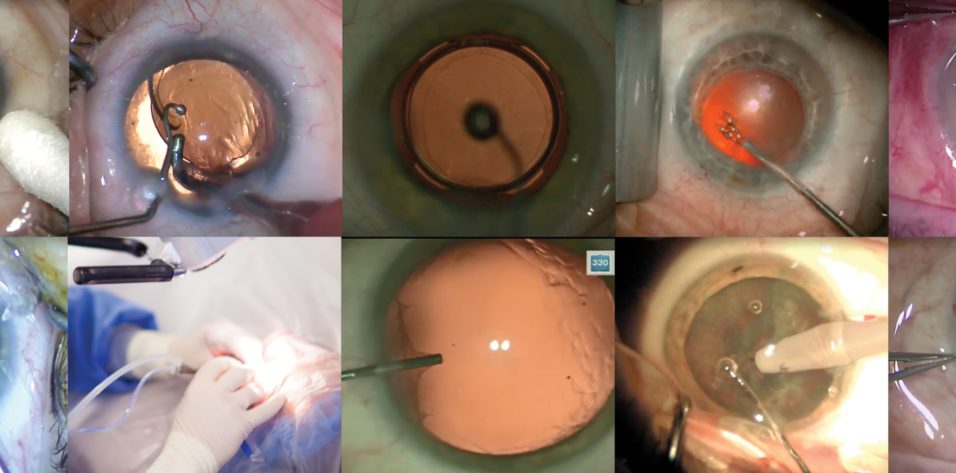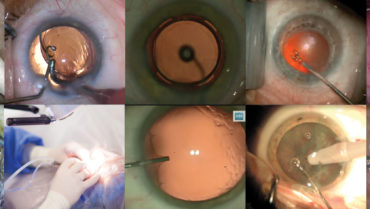
My routine cataract surgery procedure starts in the preoperative area, where patients are placed on our tried-and-true mechanical stretcher (Stryker). A nurse or nurse anesthetist places an IV while another begins numbing and dilating the eye with a premade slurry of dilating drops and topical anesthetics. Then 1 mg midazolam (Versed, Pfizer) and 1 mg fentanyl are given intravenously. This combination is usually given to patients prior to rolling them back to the OR. Once in the OR, the bed is raised to a measured height that is perfect for my chair height. The patient’s chin is elevated, and his or her forehead is wrapped and taped to the bed with paper tape. Then, the usual preparation and drape are done and the speculum is placed. A scope with an attached Ngenuity 3D Visualization System (Alcon) camera is positioned over the eye, and the scope light is out. All of this usually happens before I even enter the OR.
When I enter the OR, I simply sit down, turn on the scope light with my left foot, look at the 3D display on the Ngenuity, and fine focus on the cornea using the scope pedal. I use a custom Weinstock closed-blade lid speculum (Storz Ophthalmic Instruments). An accompanying Eyetube video (bit.ly/weinstock0220) depicts the surgical steps I take in the OR during a routine procedure.
OVD USE
When I am not using the ORA System With VerifEye (Alcon), I place Amvisc Plus (Bausch + Lomb) on the cornea, followed by 1 or 2 drops of balanced saline solution. This magnifies and stabilizes the view and obviates the need for the scrub technician to continually squirt balanced saline solution onto the eye.
Continuous application of balanced saline solution is associated with many problems. First, it takes time away from the technician performing other important tasks. Second, the patient often feels the balanced saline solution hitting the eye and, in response, he or she could move or the eye could experience a Bell reflex. If the surgeon is performing a delicate maneuver when this happens, the results could be catastrophic. Third, every time balanced saline solution hits the eye the surgical view is briefly distorted. Poor visualization during this period could potentially lead to a mistake by the surgeon. Fourth, if the technician pauses too long between squirts, the eye can dry out. This can trigger postoperative pain, epithelial defects, and a bad patient experience.
Placing OVD on the cornea prevents all these potential problems.
CORNEAL WOUNDS, CAPSULORHEXIS
I operate temporally. Rarely are there words spoken between me and the scrub technician because we have worked together for so long and so frequently that we can basically read each other’s minds—just like Tom Brady and Rob Gronkowski of the New England Patriots.
I use a custom trapezoidal 1.4- to 1.6-mm diamond blade to make two single-plane corneal wounds just inside the limbus. The wounds are approximately 70° apart and are created with a straight-in approach, parallel to the iris plane. The scrub technician starts by placing the open diamond blade in my right hand and Maumenee forceps (Katena) in my left hand. I stabilize the globe and apply counterforces with the open forceps 180° away from where I am making the wound. This two-point fixation technique avoids cyclotorsion or slippage as the blade enters the eye. I switch hands and repeat the process to create the second wound.
I close the diamond blade, place both instruments in my right hand, and pass them off while the technician places an 0.8-cc tube of Amvisc on a 27-gauge cannula in my left hand. Through the right wound, with my left hand holding the syringe and my right hand injecting, I fill the anterior chamber completely until the OVD begins to egress from both wounds. With my right hand, I place the capsulorhexis forceps (MicroSurgical Technologies) through the right wound in a clockwise direction. With the tip of the forceps open, I nick the capsule and grab the edge at the 9 clock hour, 1 to 2 mm from the center of the pupil (Figure 1). This first grasp tears it around to the 1 clock hour. I regrasp and pull inferiorly. To the right, I bring the tear to the 6 clock hour. The third and final grasp completes the rhexis.

Figure 1. Capsulorhexis forceps are used to nick the capsule and grab the edge of the rhexis.
HYDRODISSECTION AND PHACOEMULSIFICATION
I exclusively use a bimanual phaco approach with the Stellaris Elite (Bausch + Lomb). I recently began and enjoy using the Centurion Vision System (Alcon); however, I don’t have nearly the same amount of experience or confidence using it as I do with the Stellaris.
Before phacoemulsification, I use a 3-cc syringe filled with a balanced saline/lidocaine solution on a bent 27-gauge cannula and perform a quick and mild hydrodissection—just enough to see a fluid wave. With the tip of the cannula at the 6 clock hour, I gently rock back and forth until I see that it is loose. I rarely spin the nucleus more than 30° in either direction.
I then enter the left wound with a Duet irrigating handpiece (MicroSurgical Technologies), which has a Fine-Nagahara open-ended 19-gauge copper tip. I then enter the right wound with the Stellaris handpiece. I use a straight 19-gauge phaco needle with the sleeve torn off at the base. I begin sculpting straight across and usually make three passes (Figure 2), which is enough to crack the nucleus in half with the two instruments. My initial sculpt setting is 20% phaco power, 100 mm Hg vacuum, 50% duty cycle, and 30 pulses per second, and the bottle is at 80 cm. With my phaco needle I rotate the nucleus 90° to the right, sculpt three passes again, and crack the hemisphere into two roughly equal quadrants.

Figure 2. With an irrigating handpiece and a 19-gauge phaco needle, the nucleus is sculpted in three passes.
Then, by stepping on the top right button of the phaco footpedal, I advance to a second setting using 30% phaco power, a max vacuum of 500 mm Hg, 50% duty cycle, and 30 pulses per second. I engage the quadrant across the eye to the left and quickly emulsify and aspirate it. I then do a similar action on the quadrant across from it and to the right. Using the phaco needle, I spin the remaining hemisphere 180° until it is across from me, impale it, and do a stop-and-chop removal.
All phaco settings are designed to reduce heat at the bare needle. Wound burn is never seen, as long as the phaco needle and tubing are not clogged with dispersive OVD or dense cataract material. If there is an epinuclear shell, I grasp it with vacuum and remove it as a single piece. I then remove the phaco needle while I continue to irrigate with the irrigating chopper in my left hand. This acts as an anterior chamber maintainer while the scrub technician switches the aspiration tubing from the phaco handpiece to the Duet aspirating handpiece. The tip I use is a 19-gauge diamond dusted curved I/A tip with a 0.4-mm opening (MicroSurgical Technologies). With my right foot, I advance the Stellaris Elite setting to irrigation and aspiration. I circumferentially remove the cortex en bloc; occasionally I need to strip individual pieces centrally. If posterior subcapsular cataract or visible material remains against the posterior capsule, I gently polish it with the backside of the I/A tip (Figure 3). I then remove the I/A tip while I continue to irrigate and maintain chamber stability with the irrigating chopper in my left hand. The scrub technician places the remaining 0.8 cc of Amvisc in my right hand, and I stop irrigating as I fill the capsule and anterior chamber with the OVD.

Figure 3. The back surface of the aspiration tip is brushed against the posterior capsule.
IOL IMPLANTATION
My go-to monofocal IOL is the Akreos Micro Incision Lens (MI60L, Bausch + Lomb), which I inject through the right 1.4- to 1.6-mm wound using a wound-assisted technique. Other commonly used IOLs in my quiver are the Tecnis ZLB00/ZKB00 (Johnson & Johnson Vision), AcrySof IQ PanOptix Trifocal (Alcon), the Light Adjustable Lens (RxLAL, RxSight), and, for sulcus placement, the LI61AO (Bausch + Lomb). The irrigating chopper remains in the eye during lens implantation to stabilize the eye and provide counterpressure. I do not irrigate at this point to avoid flushing out the Amvisc.
Once the IOL is inside the eye, I place the bimanual I/A tip back into the right wound and use it to tuck the IOL into the capsule. I rotate the lens if needed and then irrigate and aspirate the Amvisc. Both instruments are removed, and the wounds are hydrated until the eye is sealed.
I inject 0.2 cc of diluted cefuroxime (Pfizer) using a tuberculin syringe and a 27-gauge cannula at the very end of surgery.




